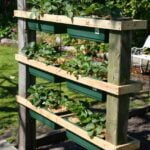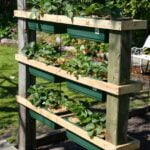Droughts can pose significant challenges for maintaining a lush and vibrant landscape, but with the right knowledge and techniques, it is possible to create a stunning and sustainable outdoor space. In this article, we will explore various strategies for designing and managing a drought-resistant landscape, from selecting the right plants to implementing efficient irrigation methods.
Whether you’re looking to revamp your current landscape or start from scratch in a water-scarce environment, these drought landscape ideas will help you create a beautiful outdoor space that thrives even in challenging conditions.
The impact of drought on landscapes can be far-reaching, affecting everything from plant health to soil moisture levels. In this section, we will delve into the effects of drought on outdoor spaces, exploring how to mitigate its impact and create a resilient landscape.
From the selection of drought-tolerant plants to the utilization of efficient irrigation techniques, there are several ways to address the challenges posed by drought in landscaping. Let’s explore some key considerations for designing a sustainable and visually appealing outdoor space in water-scarce environments.
Stay tuned as we discuss how to select drought-tolerant plants and incorporate low-maintenance hardscapes into your landscape design, as well as showcasing inspiring success stories of beautiful and sustainable drought landscapes. Learn how embracing xeriscaping principles and utilizing natural methods such as mulch and ground covers can contribute to conserving soil moisture and sustaining a healthy landscape amidst dry conditions.
Whether you’re an experienced gardener or just starting out, these practical ideas will help you create a stunning outdoor space that thrives in spite of water scarcity.
Selecting Drought-Tolerant Plants
When it comes to creating a drought-resistant landscape, selecting the right flora is crucial for the success of the design. Drought-tolerant plants are those that can survive with minimal water, making them ideal for water-scarce environments. When choosing plants for a drought landscape, it’s important to consider not only their ability to withstand dry conditions but also their aesthetic appeal and compatibility with the overall design.
To help you select the right plants for your drought-resistant landscape, here are some factors to consider:
1. Native Plants: Consider using native plants in your landscape design. These plants have adapted to the local climate and soil conditions, making them naturally more resistant to drought.
2. Water-Efficient Plants: Choose plants that are known for their water efficiency. Look for species that have low water requirements and are able to thrive in arid environments.
3. Variety of Flora: Incorporate a variety of drought-tolerant plants in your landscape to create visual interest and diversity. Mix different colors, textures, and heights to create an aesthetically pleasing environment.
By carefully selecting drought-tolerant plants for your landscape design, you can create a beautiful and sustainable outdoor space that thrives even in water-scarce conditions. Whether you opt for native species or water-efficient varieties, incorporating a diverse range of flora will contribute to the overall health and resilience of your drought-resistant landscape.
Efficient Irrigation Techniques
In drought-prone environments, it is crucial to maximize the use of water for landscape irrigation. By implementing efficient irrigation techniques, homeowners and landscapers can ensure that their gardens and outdoor spaces remain healthy and vibrant even in the face of water scarcity. Here are some tips for maximizing water use in drought landscapes:
1. Drip Irrigation: One of the most effective ways to conserve water in a drought landscape is by using drip irrigation systems. These systems deliver low volumes of water directly to the roots of plants, reducing evaporation and runoff. Additionally, drip irrigation can be combined with a timer to ensure that water is only delivered when needed, further conserving this precious resource.
2. Rainwater Harvesting: Another sustainable irrigation technique for drought landscapes is rainwater harvesting. By collecting rainwater from gutters and downspouts in barrels or cisterns, homeowners can store this free source of water for later use in watering their landscapes. This not only reduces reliance on municipal water sources but also helps to mitigate the impact of drought conditions.
3. Soil Moisture Sensors: Installing soil moisture sensors in the landscape can help optimize irrigation schedules by providing real-time data on the moisture levels in the soil. This technology allows for a more precise and efficient application of water, preventing over-irrigation while ensuring that plants receive adequate hydration.
By incorporating these efficient irrigation techniques into their landscape maintenance practices, individuals can effectively manage water resources during periods of drought while still enjoying a beautiful and thriving outdoor space.
Designing Drought-Resistant Hardscapes
When designing a drought-resistant landscape, it’s crucial to incorporate hardscapes that are both aesthetically pleasing and low-maintenance. Hardscapes can include features such as patios, pathways, retaining walls, and rock gardens. These elements not only add visual interest to the landscape but also help reduce the amount of water needed for maintenance. By integrating hardscapes into the design, you can create a beautiful outdoor space that is resilient in the face of water scarcity.
Choosing Drought-Resistant Materials
When designing hardscapes for a drought-prone environment, it’s important to select materials that are well-suited to these conditions. Opt for materials like natural stone, gravel, and decomposed granite, which require minimal watering and maintenance. These materials not only contribute to the overall aesthetic of the landscape but also stand up well to dry climates.
Embracing Minimalist Design
Incorporating low-maintenance features into your hardscape design often involves embracing a minimalist approach. Simple and streamlined designs not only require less upkeep but also complement the natural surroundings in a drought-prone landscape. Consider using clean lines and open spaces to create a visually appealing hardscape that complements the overall design of the landscape while minimizing water usage.
Utilizing Water-Efficient Hardscaping Techniques
In addition to choosing drought-resistant materials and embracing minimalist design principles, incorporating water-efficient hardscaping techniques can further enhance the sustainability of your landscape. This can include features such as permeable paving that allows rainwater to seep into the ground rather than running off, reducing the need for additional irrigation. By integrating these techniques into your hardscape design, you can create a beautiful and sustainable outdoor space that thrives in spite of water scarcity.
Creating a Xeriscape Garden
Xeriscaping is an innovative landscaping approach specifically designed for regions prone to drought and limited water availability. The term “xeriscape” comes from the Greek word “xeros”, meaning dry, and focuses on creating a sustainable and visually appealing landscape while minimizing water usage. Xeriscaping principles emphasize the use of drought-tolerant plants, efficient irrigation, soil improvement, and mulching techniques to reduce water consumption and maintenance requirements.
When embarking on the creation of a xeriscape garden, it is crucial to carefully select plants that are resilient in arid conditions. Drought-tolerant plants such as lavender, sage, yarrow, and agave are excellent choices for xeriscape gardens due to their ability to thrive with minimal water. Additionally, incorporating native plant species into the garden can help conserve water resources as these plants have adapted naturally to the local climate and soil conditions.
In order to create a successful xeriscape garden, it is essential to pay attention to proper design principles. This includes strategic placement of plants based on their water needs, grouping together those with similar irrigation requirements. Furthermore, hardscape elements such as decorative gravel pathways or rock gardens can enhance the aesthetic appeal of the xeriscape garden while reducing the need for additional watering and maintenance.
| Xeriscaping Principles | Examples |
|---|---|
| Selection of drought-tolerant plants | Lavender, sage, yarrow |
| Efficient irrigation techniques | Drip irrigation systems |
| Mulching techniques for soil preservation | Use of organic mulch materials |
Using Mulch and Ground Covers
Benefits of Using Mulch
Mulch serves as a protective layer on the soil, helping to retain moisture by reducing water evaporation. By using mulch in a drought landscape, you can significantly reduce the need for frequent watering. In addition to retaining moisture, mulch also helps suppress weed growth, regulate soil temperature, and improve soil fertility as it decomposes over time.
Choosing the Right Type of Mulch
When selecting mulch for a drought landscape, it’s important to choose materials that are suitable for conserving moisture in arid conditions. Organic mulches such as wood chips, straw, or bark are excellent choices as they break down slowly and add nutrients to the soil. Inorganic options like stones or gravel can also be effective in conserving moisture and adding visual interest to the landscape.
Utilizing Ground Covers
Ground covers are low-growing plants that spread across the ground, creating a natural carpet that helps prevent moisture loss from the soil. When choosing ground covers for a drought landscape, look for varieties that are well-suited to dry conditions and require minimal maintenance. Some popular options include sedum, thyme, and mosses which not only help conserve soil moisture but also add texture and color to the landscape.
By incorporating mulch and ground covers into your drought landscape design, you can effectively conserve soil moisture while adding beauty and functionality to your outdoor space. These natural methods not only contribute to water conservation efforts but also promote sustainability in landscaping practices.
Drought-Landscape Maintenance Tips
Maintaining a drought landscape requires a different approach than traditional landscaping. With the right maintenance routine, it is possible to sustain a healthy and thriving landscape even in the face of severe water scarcity. One important tip for maintaining a drought landscape is to regularly inspect all plants, irrigation systems, and hardscape features to ensure that they are functioning optimally.
In addition, it is crucial to monitor soil moisture levels and adjust watering schedules accordingly. This can be achieved by using efficient irrigation techniques such as drip irrigation or soaker hoses, which deliver water directly to the base of plants while minimizing evaporation. Another key aspect of drought-landscape maintenance is proper pruning and trimming of plants to encourage healthy growth and conserve water.
Furthermore, incorporating organic mulch and ground covers into the landscape can help retain soil moisture and suppress weed growth. By utilizing these natural methods, it is possible to reduce the frequency of watering while promoting the overall health of the landscape. Lastly, regular removal of debris and fallen leaves is important for preventing pests and diseases which can further stress plants in a drought-prone environment.
| Maintenance Tip | Importance |
|---|---|
| Regular Inspection | Ensuring optimal function of plants and irrigation systems |
| Monitoring Soil Moisture Levels | Adjusting watering schedules for efficient water use |
| Proper Pruning and Trimming | Promoting healthy growth while conserving water |
| Utilizing Mulch and Ground Covers | Retaining soil moisture and suppressing weed growth |
Showcasing Drought Landscape Success Stories
In conclusion, creating a beautiful and sustainable drought landscape is not only possible, but it is also becoming increasingly essential in the face of climate change and water scarcity. By understanding the impact of drought on landscapes, selecting the right plants, implementing efficient irrigation techniques, designing hardscapes that require low maintenance, embracing xeriscaping principles, using mulch and ground covers, and establishing a good maintenance routine, homeowners and landscapers can create stunning outdoor spaces that thrive despite water limitations.
One of the keys to success when it comes to drought landscapes is selecting the right plants. By choosing drought-tolerant flora that can thrive with minimal water, homeowners can ensure that their landscapes remain vibrant and healthy even in times of water scarcity. Additionally, implementing efficient irrigation techniques such as drip irrigation or rainwater harvesting can help maximize water use and minimize waste in drought-prone environments.
Furthermore, showcasing successful examples of drought landscapes can provide inspiration and guidance for those looking to transform their outdoor spaces. By highlighting beautiful and sustainable drought landscape designs, individuals can learn from others’ experiences and gain valuable insight into creating their own water-wise gardens. Overall, with the right knowledge, planning, and implementation of drought landscape ideas, anyone can achieve a stunning outdoor oasis while conserving water resources.
Frequently Asked Questions
How Can I Landscape Without Water?
Landscaping without water can be achieved by using drought-resistant plants, native to your region, that require minimal watering. Incorporating rocks, gravel, and mulch can also help retain moisture in the soil. Additionally, utilizing efficient irrigation systems like drip irrigation can help minimize water usage in your landscape.
How Do You Make a Drought Resistant Yard?
To create a drought-resistant yard, start by selecting plants that are adapted to low-water conditions and grouping them together based on their water needs. Amend the soil with organic matter to improve its water-holding capacity and mulch the topsoil to reduce evaporation.
Implementing water-saving techniques such as rainwater harvesting, using permeable paving, and installing a smart irrigation system will also contribute to creating a drought-resistant yard.
What Is a Drought-Tolerant Landscape?
A drought-tolerant landscape is designed to thrive with minimal water input and is composed of plants that can withstand prolonged periods of drought. These landscapes often feature succulents, cacti, ornamental grasses, and other low-water-use plants.
Drought-tolerant landscapes may also incorporate xeriscaping principles such as using native plants, optimizing soil health, and minimizing turf areas to reduce water consumption. Overall, the goal is to create a visually appealing landscape that conserves water resources.

Welcome to my gardening blog! I am passionate about plants and enjoy sharing my knowledge and experiences with others. In this blog, I will write about everything related to gardening, from tips on how to get started to updates on my own garden projects.





